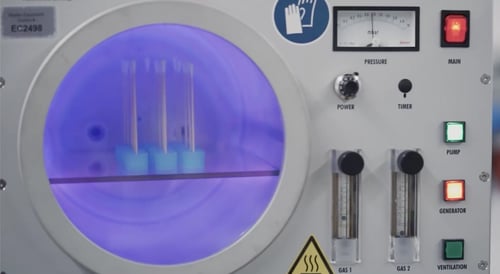
Physical Vapor Deposition - Plasma units • PVD applications • Coating for metalworking
Physical vapor deposition (PVD) differs from chemical vapor deposition (CVD) in the sense that the former process only relies on physical processes to transfer the coating materials into the gas phase. The latter commonly uses precursors that are already gaseous. CVD coatings can be obtained in many different forms, such as amorphous, epitaxial, mono-, or polycrystalline. The most common materials that are deposited with CVD are carbon, silicon as well as nitrides or oxides. However, the use of metals in CVD processes is somehow limited. This is where PVD comes in. Physical Vapor Deposition is the workhorse when it comes to depositing high-temperature materials, such as metals or ceramics.
PVD coatings come with several advantages; they are usually very corrosion-resistant and can withstand high temperatures. They are hard and wear-resistant, which makes them very durable. Thus, they can be utilized as a protective top layer for other materials, such as plastic. PVD films can be made from nearly any material and also coat a large variety of substrates, which makes this process very flexible. The coating process is also quite environmentally friendly because no solvents or corrosive chemical agents are needed. Furthermore, it is possible that the desired deposition can be obtained with more than one PVC technology.
There are some minor downsides as well: PVD usually needs vacuum equipment and some materials, like diamond cannot be deposited with physical vapor deposition. However, otherwise, PVD is a very versatile technology that is applied in many different areas of industry and research.
There are several different possibilities for realizing PVD processes. The most prominent one is sputtering, or sputter deposition. Sputtering occurs when highly energetic particles hit a surface with great velocity. If the kinetic energy is high enough each impinging particle will yank out one or more atoms or molecules from this target. If this process is done in a vacuum environment, the sputtered particles can be deposited on a substrate vis-à-vis from the sputter target. Sputtering can be done with a wide range of materials, including metals like copper, gold, silver, tungsten, or titanium. Of course, it is also possible to deposit alloy thin films using sputtering. Other possible target materials are carbon, nitrides, or oxides such as zinc oxide, tin oxide, or titanium nitride. To obtain more complex depositions, reactive sputtering can be applied. This technology works like ‘ordinary’ sputtering but some amount of reactive gas is introduced into the vacuum chamber. The sputtered particles can react in this chemically active atmosphere on their way from the target to the substrate. This enhances the number of possibilities for high-tech sputter coatings even further.
Evaporation deposition is another common form of PVD deposition that also needs a good vacuum environment. The raw material for the coating is thermally evaporated and condenses on the desired substrate. This method is often used for metal thin-film deposition, for example, aluminum or silver films on various substrates. Evaporation is a standard process for manufacturing mirrors (with glass as substrate), or aluminized PET foils. Although it is possible to coat some heat-sensitive materials like PET, there are some limits to the heat sensitivity of the substrate. Thus, this method cannot be used for any kind of coating or any kind of substrate.
Another form of physical vapor deposition technology is, for example, cathodic arc deposition, where an extremely hot electric arc evaporates parts of a target surface and ionizes the resulting vapors before they are deposited onto the substrate. There is also the possibility of using pulsed laser deposition, where strong laser pulses ablate the top layer of the target material, turning them into vapor. Yet another form of PVD coatings can be achieved by electron-beam PVD, where the target is heated by a collimated electron beam until it evaporates and condenses on the substrate surface. There are other types as well but the aforementioned ones are the most common PVD coating technologies.
Many modern industries use PVD technologies for their manufacturing. Here are some examples of industries that utilize PVD:
Toolmakers: As a result of its ability to deposit hard coatings like chromium nitride and titanium nitride, PVD has become an essential material for manufacturing high-quality tools. Examples are drills, cutting tools as well as screwdrivers. Physical vapor deposition coatings are very useful in protecting tools and machinery from corrosion.
Aerospace and Automotive: Here PVD deposition techniques are mostly used to improve wear resistance of metal parts, or to make them corrosion resistant. Very often, parts of the engine or the chassis are treated with a protective hard coating.
Jewelry and design: PVD not only can deposit precious metals like gold, silver and platinum to give items luxuriant aesthetics but it can also be used to color stainless steel parts. This is commonly done by thin films of brass, silver, or gold on top of the steel substrate.
Optics: The possible applications for PVD depositions in optics range from the production of highly sophisticated mirrors to specially coated glasses. Protective, reflective, or absorbing layers can be deposited on glass sheets, lenses, prisms, or other optical components. Those products are used in modern high-tech optics, ranging from laser components to optical instruments.
Semiconductors: PVD (mostly sputtering) is used in two main fields, related to semiconductor applications: Microchips and thin film photovoltaic cells. In the former, mostly metals like platinum, tungsten, or copper are sputter-coated; sometimes in multilayered depositions. In the latter, rare earths, metals, or composites of both are coated on glass or plastic substrates. The most frequently used materials are copper, indium, gallium, or tellurium (or alloys of those).
To learn more about the use of plasma in manufacturing, please read our eBook titled "Manufacturer’s Surface Activation Guide for Improved Adhesion."
Plasma: +1 (248) 761 9253
Distribution: +1 (248) 549 8600
Fax: +1 (248) 549 3533
info@thierry-corp.com